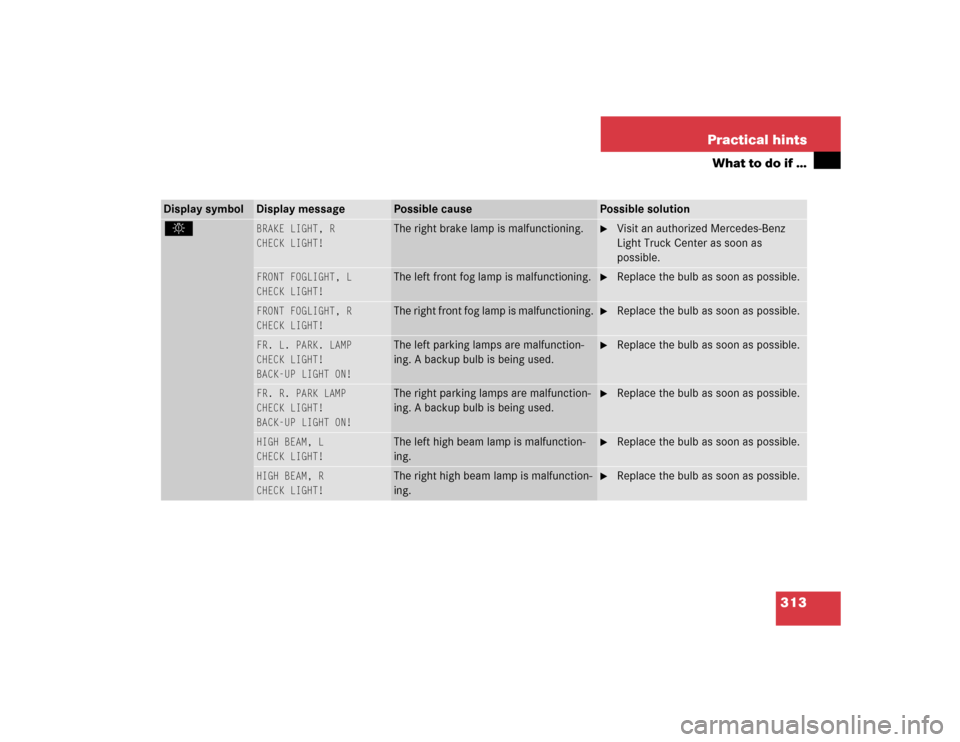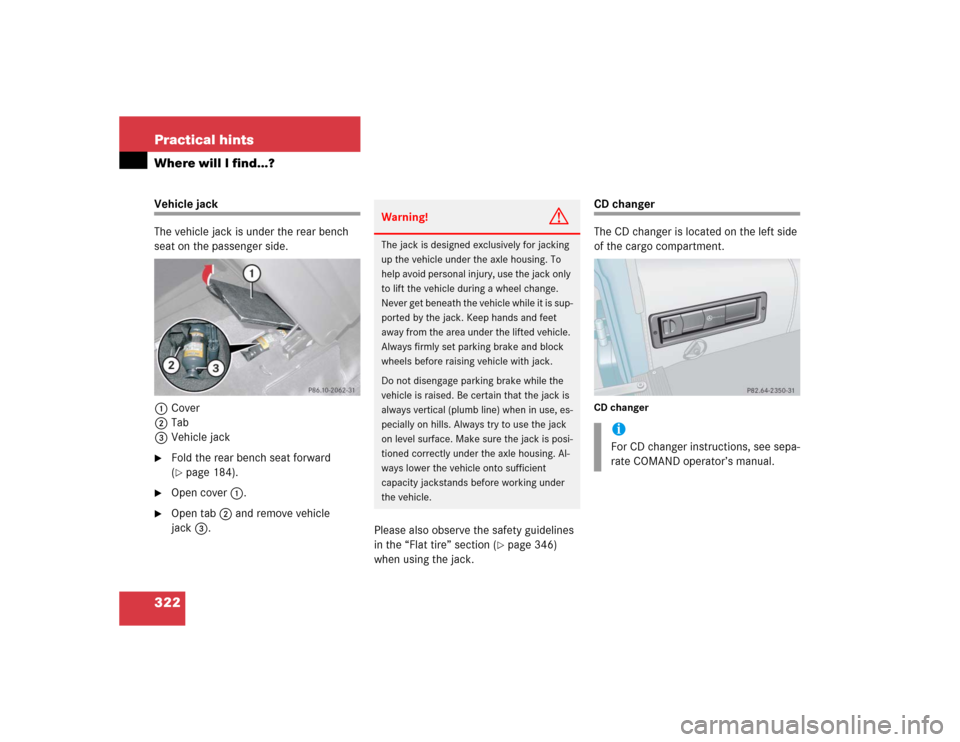Page 218 of 416

218 OperationDriving instructionsAfter hard braking, it is advisable to drive
on for some time, rather than immediately
parking, so the air stream will cool down
the brakes faster.
Driving off
Apply the brakes to test them briefly after
driving off. Perform this procedure only
when the road is clear of other traffic.
Warm up the engine smoothly. Do not
place full load on the engine until the oper-
ating temperature has been reached.
When starting off on a slippery surface, do
not allow a drive wheel to spin for an ex-
tended period with the ESP switched off.
Doing so may cause serious damage to the
drivetrain which is not covered by the
Mercedes-Benz Limited Warranty.
To ensure sufficient traction during
off-road driving, activate differential locks
as needed (
�page 158).
Parking
Warning!
G
If other than recommended brake pads are
installed, or other than recommended brake
fluid is used, the braking properties of the
vehicle can be degraded to an extent that
safe braking is substantially impaired. This
could result in an accident.!When driving down long and steep
grades, relieve the load on the brakes
by selecting gear range3,2 or1 on the
automatic transmission to use the
engine’s braking power (
�page 150).
This helps prevent overheating of the
brakes and reduces brake pad wear.
Warning!
G
Do not park this vehicle in areas where com-
bustible materials such as grass, hay or
leaves can come into contact with the hot
exhaust system, as these materials could be
ignited and cause a vehicle fire.
To reduce the risk of personal injury as a re-
sult of vehicle movement, before
turning off
the engine and leaving the vehicle always:
�
Keep right foot on brake pedal.
�
Pull the parking brake lever up as many
notches as possible.
�
Move the selector lever to positionP.
�
Slowly release brake pedal.
�
When parked on an incline, turn front
wheel towards the road curb.
Page 219 of 416

219 Operation
Driving instructions
Tires
Treadwear indicators (TWI) are required by
law. These indicators are located in six
places on the tread circumference and be-
come visible at a tread depth of approxi-
mately
1/16
in (1.6 mm), at which point
the tire is considered worn and should be
replaced.The treadwear indicator appears as a solid
band across the tread.
Specified tire inflation pressures must be
maintained. This applies particularly if the
tires are subject to high loads (e.g. high
speeds, heavy loads, high ambient temper-
atures).
�
Turn the SmartKey in the starter switch
to position0 and remove the SmartKey
from the starter switch.
�
Take the SmartKey and lock vehicle
when leaving.!Set the parking brake whenever park-
ing or leaving the vehicle. In addition,
move gear selector lever to positionP.
In addition, when parking on hills turn
front wheel towards the road curb.
Warning!
G
If you feel a sudden significant vibration or
ride disturbance, or you suspect that possi-
ble damage to your vehicle has occurred,
you should turn on the hazard warning flash-
ers, carefully slow down, and drive with cau-
tion to an area which is a safe distance from
the road.
Inspect the tires and the vehicle underbody
for possible damage. If the vehicle or tires
appear unsafe, have it towed to the nearest
Mercedes-Benz Light Truck Center or tire
dealer for repairs.
Warning!
G
Although the applicable federal motor vehi-
cle safety laws consider a tire to be worn
when the treadwear indicators (TWI) be-
come visible at approximately
1/16in
(1.6 mm), we recommend that you do not al-
low your tires to wear down to that level. As
tread depth approaches
1/8in (3.0 mm),
the adhesion properties on a wet road are
sharply reduced.
Depending upon the weather and/or road
surface (conditions), the tire traction varies
widely.
Page 288 of 416

288 Practical hintsWhat to do if …Lamps in instrument clusterGeneral information:
If any of the following lamps in the instru-
ment cluster fails to come on during thebulb self-check when switching on ignition,
have the respective bulb checked and re-
placed if necessary.Problem
Possible cause
Suggested solution
-
The yellow ABS indicator lamp
comes on while driving.
You engaged the differential locks. The ABS,
ESP, BAS, EBB and 4-ETS are switched off.
�
The driving systems will switch on
again after the differential locks have
been disengaged.
The ABS has detected a malfunction and has
switched off. The ESP, BAS, EBB and 4-ETS
are also switched off (see messages in dis-
play).
If the ABS control unit is malfunctioning, oth-
er systems such as the navigation system or
Rear Parking Assist* may also malfunction.
The brake system is still functioning normally
but without the ABS available.
�
Continue driving with added caution.
Wheels will lock during hard braking
reducing steering capability.
�
Have the system checked at an autho-
rized Mercedes-Benz Light Truck
Center as soon as possible.
Failure to follow these instructions in-
creases the risk of an accident.
Page 290 of 416

290 Practical hintsWhat to do if …Problem
Possible cause
Suggested solution
;
(USA only)
3
(Canada only)The red brake warning lamp
comes on while driving and you
hear a warning sound.
You are driving with the parking brake set.
�
Release the parking brake
(�page 50).
�
Also note the messages in the multi-
function display (
�page 296).
The red brake warning lamp
comes on while driving.
There is insufficient brake fluid in the reser-
voir.
�
Risk of accident! Carefully stop the
vehicle and notify an authorized
Mercedes-Benz Light Truck Center.
Do not add brake fluid! This will not
solve the problem.
�
Also note the messages in the multi-
function display (
�page 296).
Warning!
G
Driving with the brake warning lamp illumi-
nated can result in an accident. Have your
brake system checked immediately if the
brake warning lamp stays on.
Do not add brake fluid before checking the
brake system. Overfilling the brake fluid res-
ervoir can result in spilling brake fluid on hot
engine parts and the brake fluid catching
fire. You could be seriously burned.
!If you find that the brake fluid in the
brake fluid reservoir has fallen to the
minimum mark or below, have the
brake system checked for brake pad
thickness and leaks.
Page 304 of 416
304 Practical hintsWhat to do if …Display symbol
Display message
Possible cause
Possible solution
3
ELEC. BRAKE BOOST.
VISIT WORKSHOP!
The EBB has detected a malfunction and
has switched off.
The brake system is still functioning nor-
mally but without the EBB available.
�
Continue driving with added cau-
tion.
�
Have the system checked at an au-
thorized Mercedes-Benz Light Truck
Center as soon as possible.
Failure to follow these instructions in-
creases the risk of accident.
;
(USA only)
!
(Canada only)
PARK. BRAKE
RELEASE BRAKE!
You are driving with the parking brake
set.
�
Release the parking brake
(�page 50).
Page 313 of 416

313 Practical hints
What to do if …
Display symbol
Display message
Possible cause
Possible solution
.
BRAKE LIGHT, R
CHECK LIGHT!
The right brake lamp is malfunctioning.
�
Visit an authorized Mercedes-Benz
Light Truck Center as soon as
possible.
FRONT FOGLIGHT, L
CHECK LIGHT!
The left front fog lamp is malfunctioning.
�
Replace the bulb as soon as possible.
FRONT FOGLIGHT, R
CHECK LIGHT!
The right front fog lamp is malfunctioning.
�
Replace the bulb as soon as possible.
FR. L. PARK. LAMP
CHECK LIGHT!
BACK-UP LIGHT ON!
The left parking lamps are malfunction-
ing. A backup bulb is being used.
�
Replace the bulb as soon as possible.
FR. R. PARK LAMP
CHECK LIGHT!
BACK-UP LIGHT ON!
The right parking lamps are malfunction-
ing. A backup bulb is being used.
�
Replace the bulb as soon as possible.
HIGH BEAM, L
CHECK LIGHT!
The left high beam lamp is malfunction-
ing.
�
Replace the bulb as soon as possible.
HIGH BEAM, R
CHECK LIGHT!
The right high beam lamp is malfunction-
ing.
�
Replace the bulb as soon as possible.
Page 318 of 416
318 Practical hintsWhat to do if …Display symbol
Display message
Possible cause
Possible solution
<
SEAT BELT SYSTEM
DRIVE TO WORKSHOP!
The seat belt system is malfunctioning.
�
Visit an authorized Mercedes-Benz
Light Truck Center as soon as
possible.
§
TC IN NEUTRAL
No gear has been selected in the transfer
case, it is in NEUTRAL.
�
Engage transfer case to gear position
HIGH or LOW (
�page 154).
Warning!
G
If the transfer case is in NEUTRAL, the
Pposition of transmission will not hold vehi-
cle. The parking brake must be applied to
hold vehicle in place.
Page 322 of 416

322 Practical hintsWhere will I find...?Vehicle jack
The vehicle jack is under the rear bench
seat on the passenger side.
1Cover
2Tab
3Vehicle jack�
Fold the rear bench seat forward
(�page 184).
�
Open cover1.
�
Open tab2 and remove vehicle
jack3.
Please also observe the safety guidelines
in the “Flat tire” section (
�page 346)
when using the jack.
CD changer
The CD changer is located on the left side
of the cargo compartment.CD changer
Warning!
G
The jack is designed exclusively for jacking
up the vehicle under the axle housing. To
help avoid personal injury, use the jack only
to lift the vehicle during a wheel change.
Never get beneath the vehicle while it is sup-
ported by the jack. Keep hands and feet
away from the area under the lifted vehicle.
Always firmly set parking brake and block
wheels before raising vehicle with jack.
Do not disengage parking brake while the
vehicle is raised. Be certain that the jack is
always vertical (plumb line) when in use, es-
pecially on hills. Always try to use the jack
on level surface. Make sure the jack is posi-
tioned correctly under the axle housing. Al-
ways lower the vehicle onto sufficient
capacity jackstands before working under
the vehicle.
iFor CD changer instructions, see sepa-
rate COMAND operator’s manual.